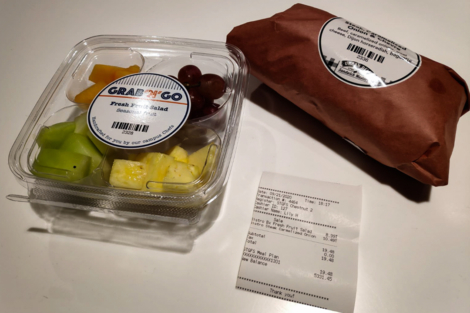Dons and students have raised concerns about the new dining plans at Chestnut Residence and New College, which have moved from an “all-you-care-to-eat” model to a declining balance model. Alongside health and environmental concerns surrounding recent changes, dons claim that this new model poses a barrier to the ability to afford three nutritious meals a day.
In response, these dons and students have also released a petition with over 400 signatures so far. The key demands include more consultation with students, staff, and food experts; a reduction in prices; and a different pricing structure that doesn’t discourage students from choosing healthy options.
Colin Porter, Executive Director Food and Beverage Services & Campus Events wrote to The Varsity that buffet-style food service is prohibited due to COVID-19 and that these restrictions were a primary reason for the new model.
Affordability
Previously, the dining halls operated under an “all-you-can-eat” structure where students would swipe their TCard and have unlimited access to food during that visit to the dining hall through their meal plan. Now, with a “declining balance” model, students must pay for each item individually, including drinks, snacks, and some condiments such as jam and peanut butter.
Dons at Chestnut and New College claim that the new model also provides less options for students with dietary restrictions and less ability to customize food options.
Sterlin Vaillancourt, a lead don at New College and a Master of Social Work student, said that a “majority of students are feeling some kind of frustrations about this, even if it’s not outright because, at the end of the day, we still need to eat here,” since the meal plan is required as part of living in residence. For the 2020–2021 school year, the standard dining plan is $5,495 and a lite dining plan costs $4,850.
Based on the dollars allotted for the year, the amount residents can spend each day is $24. However, dons at New College and Chestnut estimate that the average single meal costs around $14, not including drinks or dessert.
In one example shared by the dons, the cost for one sandwich and a small container of fruit came to $19.48. Vaillancourt said that the average entrée can start around $14 and go up to $20 if it is a bigger portion. They also noted that the cost of some items is higher than it would be elsewhere. For example, a single banana, apple, or orange costs $1.15.
“We don’t even have the option of eating three meals a day,” added Nadine Abdel-Ghafar, a graduate student and don at Chestnut. “We are a dining hall, and we should be offering at least a minimum [of] three meals a day.”
Consequently, the dons anticipate that many students may use up their meal plan for the whole year by the start of the second semester. “There’s absolutely zero way that if you have an 18-year-old person eating at this cafeteria, you wouldn’t need additional funds to see you through the end of the year,” said Mike Lawler, another graduate student and don at Chestnut.
Residence dons, who receive meal plans as part of their employment compensation, will have to pay out of pocket if they use up the dollars allotted to them this year. Having to spend money to feed themselves in the residences was not a concern for dons in years prior. The new system may also be difficult for some students, such as student athletes, who require a higher caloric intake.
In addition, the high prices may encourage students to seek out other food options outside of the residence, which brings additional concerns with regard to increasing contacts during COVID-19. Vaillancourt mentioned that some students may not be comfortable being out in public due to the virus, leaving the dining hall as their only option.
Another factor is that Chestnut Residence has no kitchens or any cooking facilities accessible to students except microwaves. At New College, while the residences previously offered some access to stoves and ovens, these communal amenities are restricted due to COVID-19.

A sandwich and fruit cup costs $19.48. COURTESY OF MIKE LAWLER
Health concerns
The dons believe that these changes could lead to disordered eating, as students may skip meals if they cannot afford to eat three meals a day under the new structure. “I’ve been told by my students… how they plan their schedules around which meals they can afford to skip,” said Abdel-Ghafar. “They have not been eating their three meals a day.” The weighing of food may also have a negative impact on students’ relationships with food.
“The system wasn’t designed to ensure students could eat for that budget,” said Lawler. He claims that “this system was designed to maximize profits.”
According to Porter, the pay-per-weight structure would be removed from “multiple stations” soon in response to the concerns that were raised. However, Porter disputed the allegation that profit was a factor in the decision.
For food options that are paid for by weight, students are not able to choose how much food to take in one portion due to the elimination of buffet-style options, leaving them unable to choose the quantity or cost of their meals. Another concern in the pay-by-weight model is paying for things that are not edible, such as the weight of bones in meat.
Porter wrote in response that the pay-per-item and pay-per-weight structures were introduced “to provide our students with a level of control over selections and portioning within the declining balance program.”
The pricing may also encourage students to go for the unhealthy options, and many more of them have been introduced to the dining hall starting this year, such as instant noodles and packaged snacks. The dining halls now also sell candy and gum.
On the problematic pricing structure, Lawler explained that a fruit cup costs $9 while a burger costs $8. “If you’re a student, and you’re making the choice between a fruit cup or a burger and fries — which will fill you — you’re obviously going to make that choice… to have something that fills you as opposed to something that’s healthier.”
Environmental impact
The new model introduces many more single-use plastic items into the dining hall as many prepackaged food items have been introduced for the first time. In addition, the compost has been removed from the dining halls.
The Chestnut dons say that their questions about the environmental impact of the change as a whole have not been adequately addressed. They have had two meetings with food services over their concerns, but Lawler and Abdel-Ghafar expressed disappointment that their questions have not been answered adequately.
Lawler noted that the reusable eco-trays are not compatible with all food options, and according to the Chestnut Residence website, if a student loses the card that can be exchanged for the eco-tray, they must pay $5 to get a new one.
Porter noted that some changes to the system will be implemented soon and wrote, “We are also seeking to identify an ongoing mechanism for soliciting student feedback to continually monitor and adjust as the school year continues.”


